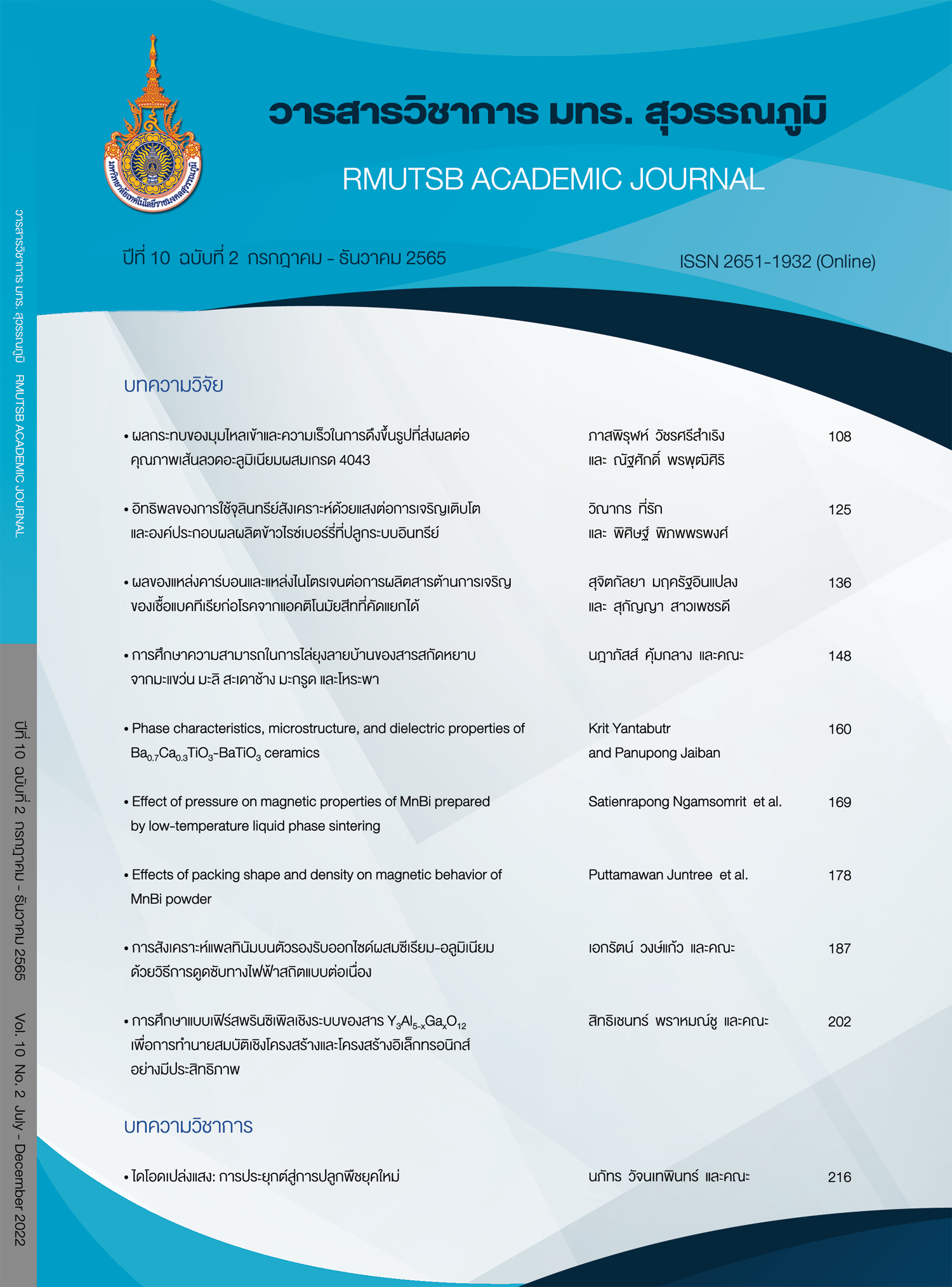ผลกระทบของมุมไหลเข้าและความเร็วในการดึงขึ้นรูปที่ส่งผลต่อคุณภาพ เส้นลวดอะลูมิเนียมผสมเกรด 4043
Main Article Content
บทคัดย่อ
งานวิจัยนี้มีวัตถุประสงค์เพื่อศึกษาผลกระทบของขนาดมุมไหลเข้าแม่พิมพ์และความเร็วในการดึงขึ้นรูปที่ส่งผลต่อคุณภาพเส้นลวดอะลูมิเนียมผสมเกรด 4043 ชิ้นงานเริ่มต้นมีขนาดเส้นผ่านศูนย์กลาง 2.0 มิลลิเมตร ถูกทดลองด้วยการดึงผ่านดายที่มีขนาดมุมไหลเข้าต่างกัน 3 ระดับ ได้แก่ 16°, 18° และ 20° อินเสิร์ทดายทำจากวัสดุทังสเตนคาร์ไบด์ เกรด K20 (ISO) และถูกสวมอัดเข้ากับแม่พิมพ์ส่วนนอกทำจากวัสดุเกรด D2 (AISI) โดยการออกแบบกำหนดให้ลักษณะของดายเป็นไปตามมาตรฐาน ISO2084 ค่าความเร็วในการดึงขึ้นรูปที่ศึกษามี 3 ระดับ คือ 0.10, 0.25 และ 0.40 เมตร/วินาที ขณะทำการดึงขึ้นรูปใช้สารหล่อลื่นชนิด Renoform MZA30 เพื่อให้ได้เส้นลวดสำเร็จขนาดเส้นผ่านศูนย์กลาง 1.9 มิลลิเมตร โดยในการดำเนินการวิจัยจะเป็นลักษณะของการประยุกต์ใช้การออกแบบการทดลองแบบแฟกทอเรียลเต็มรูปแบบ 32 ซึ่งผลการทดลองพบว่าแรงดึงขึ้นรูปแปรผันตามขนาดมุมไหลเข้าแม่พิมพ์แต่แปรผกผันกับความเร็วในการดึงขึ้นรูปลวด การดึงขึ้นรูปชิ้นงานเริ่มต้นผ่านดายที่มีมุมไหลเข้าขนาดเล็กกว่าจะให้ค่าความหยาบผิวเฉลี่ยของเส้นลวดสำเร็จดีกว่าการดึงขึ้นรูปผ่านแม่พิมพ์ที่มีมุมไหลเข้าขนาดใหญ่ ในขณะที่การดึงขึ้นรูปผ่านแม่พิมพ์ที่มีมุมไหลเข้าขนาดใหญ่จะส่งผลให้เกิดการเปลี่ยนรูปถาวรแบบรีดันแดนต์ทำให้เกิดความเค้นตกค้างในเส้นลวดเพิ่มสูงขึ้นจึงทำให้เส้นลวดสำเร็จมีความแข็งแรงเพิ่มขึ้น โดยเฉพาะกับการดึงขึ้นรูปลวดที่ใช้ความเร็วในการดึงขึ้นรูปสูง
Article Details

อนุญาตภายใต้เงื่อนไข Creative Commons Attribution-NonCommercial-NoDerivatives 4.0 International License.
ต้นฉบับที่ได้รับการตีพิมพ์ถือเป็นสิทธิของเจ้าของต้นฉบับและของวารสารวิชาการ มทร.สุวรรณภูมิ เนื้อหาบทความในวารสารเป็นแนวคิดของผู้แต่ง มิใช่เป็นความคิดเห็นของคณะกรรมการการจัดทำวารสาร และมิใช่ความรับผิดชอบของมหาวิทยาลัยเทคโนโลยีราชมงคลสุวรรณภูมิ
เอกสารอ้างอิง
Celentano, D. J., Palacios, M. A., Rojas, E. L., Cruchaga, M. A., Artigas, A. A., & Monsalve, A. E. (2009). Simulation and experimental validation of multiple step wiredrawing processes. Finite Elements in Analysis and Design, 45(3), 163-180.
Cetinarslan, C. S. (2012). A study on influences of some process parameters on cold drawing of ferrous wires. Indian Journal of Engineering & Material Sciences, 19, 221-228.
El-Domiaty, A., & Kassab, S. Z. (1998). Temperature rise in wire-drawing. Journal of Materials Processing Technology, 83(1-3), 72-83.
Haddi, A., Imad, A., & Vega, G. (2001). Analysis of temperature and speed effects on the drawing stress for improving the wire drawing process. Materials & Design, 32(8-9), 4310-4315.
Hafis, S. M., Ridzuan, M. J. M., Rahayu Mohamed, A., Farahana, R. N., & Syahrullail, S. (2013). Minimum quantity lubrication in cold work drawing process: Effects on forming load and surface roughness. Procedia Engineering,
, 639-646.
International Standard. (1996). ISO 2804:1996 - Wire, bar or tube drawing dies, Second edition 1996-l 2-l 5. Geneva: ISO.
Kaewtatip, P. (2001). A Study on the effect of drawing speed on the performances of wire drawing process. ME-NETT 15th Conferences (pp. 151-155). Bangkok: Srinakharinwirot University.
Lin, H. S., Hsu, Y. C., & Keh, C. C. (2008). Inhomogeneous deformation and residual stress in skinpass axisymmetric drawing. Journal of Materials Processing Technology, 201(1-3), 128-132.
Majzoobi, G. H., Fereshteh Saniee, F., & Aghili, A. (2008). An investigation into the effect of redundant shear deformation in bar drawing. Journal of Materials Processing Technology, 201(1-3), 133-137.
Martinez, G. A. S., Santos, E. F. d., Kabayama, L. K., Guidi, E. S., & Silva, F. d. A. (2019). Influences of different die bearing geometries on the wire-drawing process. Metals, 9(10), 1089.
Martinez, G. A. S., Qian, W. L., Kabayama, L. K, & Prisco, U. (2020). Effect of process parameters in copper‐wire drawing. Metals, 10(1), 105.
Pilarczyk, J. W., Markowski, J., Dyja, H., & Golis, B. (2004). Effect of high-speed drawing on properties of high-carbon steel wires. Wire Journal International, 37, 118-123.
Pornputsiri, N. (2017). Stainless wire drawing process factors affecting on finished wire quality. RMUTI Journal Science and Technology, 10(3), 14-31. (in Thai)
Rodríguez-Alabanda, O., Molero, E., Tintelecan, M., Guerrero-Vaca, G., Romero, P. E., & Santana Martinez, G. A. (2020). Fine electrolytic tough pitch copper multistage wiredrawing pass schedule design by analytical and numerical methods. Proceedings, 63(1), 12.
Roger, N. W. (2016). Wire technology: Process engineering and metallurgy (2nd ed.). Burlington, MA: Butterworth-Heinemann.
Siebel, E., & Kobitzsch, R. (1943). Die Erwarmung des Ziehgutes beim Drahtziehen. Stahl Und Eisen, 63(6), 110-113.
Suliga, M. (2017). The influence of drawing speed on surface topography of high carbon steel wires. Metalurgija, 56, 182-184.
Vega, G., Haddi, A., & Imad, A. (2009a). Temperature effects on wire-drawing process: experimental investigation. International Journal of Material Forming, 2, 229-232.
Vega, G., Haddi, A., & Imad, A. (2009b). Investigation of process parameters effect on the copper wire drawing. Materials and Design, 30(8), 3308-3312.
Viktor, T. (2010). Steel wire production by cold drawing. Hochschule Anhalt, 1, 70-83.


